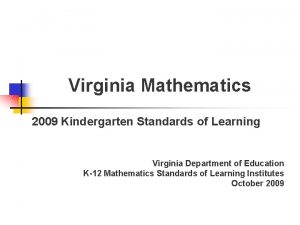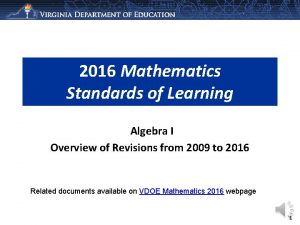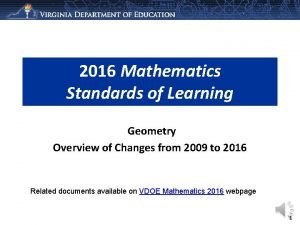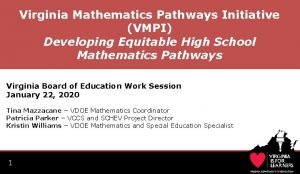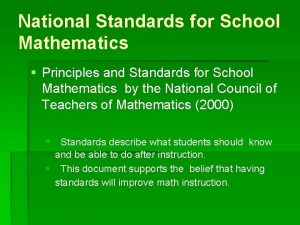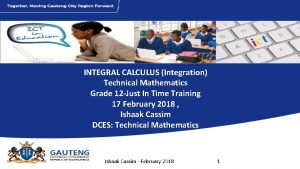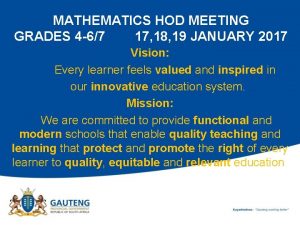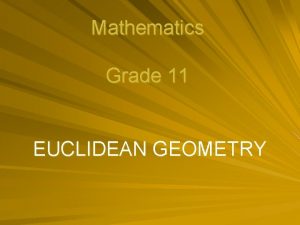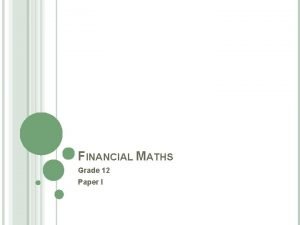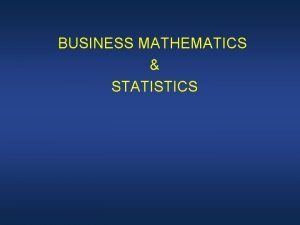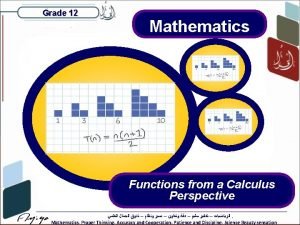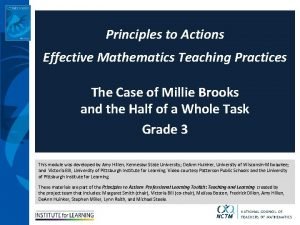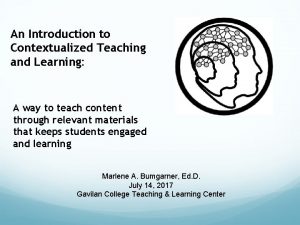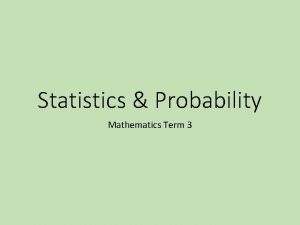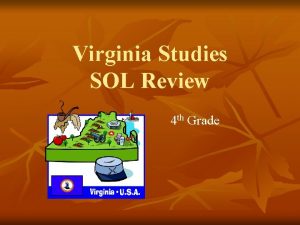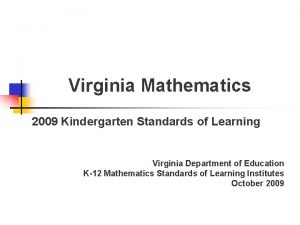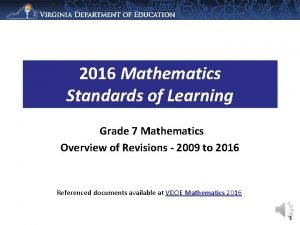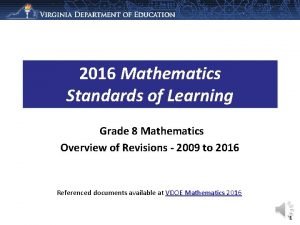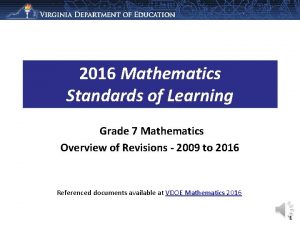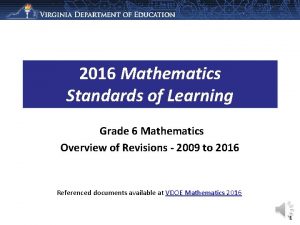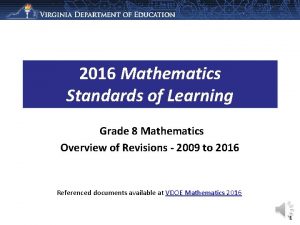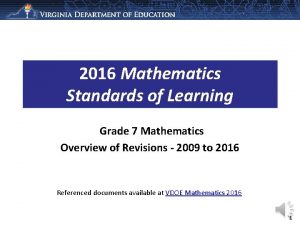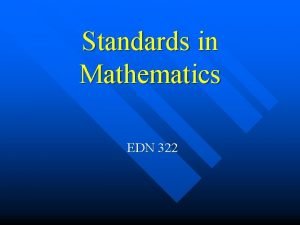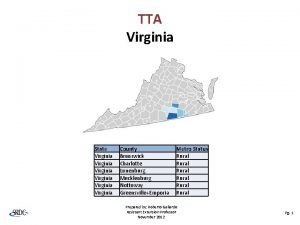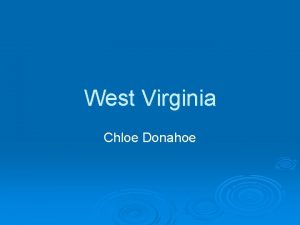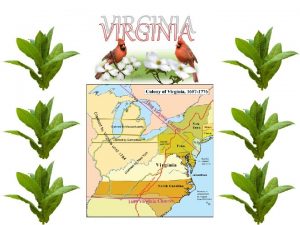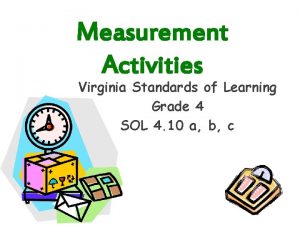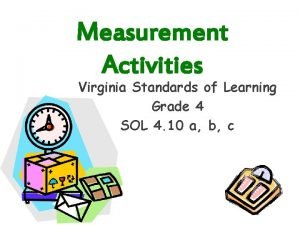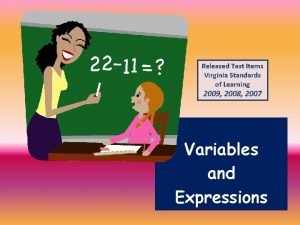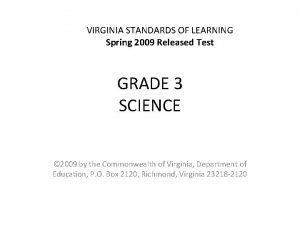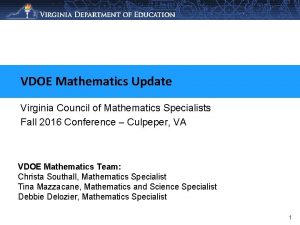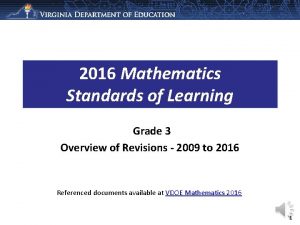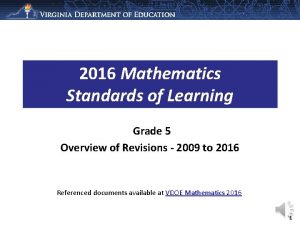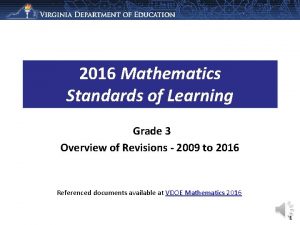Virginia Mathematics 2009 Grade 1 Standards of Learning
























- Slides: 24

Virginia Mathematics 2009 Grade 1 Standards of Learning Virginia Department of Education K-12 Mathematics Standards of Learning Institutes October 2009

Major SOL Changes Number and Number Sense n n n Count and write numerals 0 -100. Count to 100 by 2’s. Count backward from 30. Identify the part of a set or region that represent a fraction for halves, thirds, and fourths. Write the fraction.

Major SOL Changes Computation and Estimation n Recall basic addition facts to 18 and the corresponding subtraction facts. n Create and solve story and picture problems using addition facts to 18 and the corresponding subtraction facts.

Major SOL Changes Measurement n Use nonstandard units to measure volume. n Use a balance scale to compare the weights of two objects. n Use calendar language appropriately (yesterday, next week, last week).

Major SOL Changes Geometry n Proximity is moved to the Curriculum Framework. n Square corners are now accurately referred to as right angles.

Major SOL Changes Probability and Statistics n No change.

Major SOL Changes Patterns, Functions, and Algebra n Recognize the equal sign as a representation of equivalence.

Major Changes Related SOL have been combined to create one SOL with bullets EX: (2001) 1. 2 The student will group a collection of up to 100 objects into tens and ones and write the corresponding numeral to develop an understanding of place value. [Moved to new SOL 1. 1 b] (2009) 1. 1 The student will a) count from 0 to 100 and write the corresponding numerals; and b) group a collection of up to 100 objects into tens and ones and write the corresponding numeral to develop an understanding of place value.

Major Changes Details on instructional strategies have been removed for potential placement in the curriculum framework EX: (2001) 1. 13 The student will compare the volumes of two given containers by using concrete materials (e. g. , jelly beans, sand, water, rice). (2009) 1. 10 The student will compare using the concepts of more, less, and equivalent, a) the volumes of two given containers by using concrete materials (e. g. , jelly beans, sand, water, rice) [Move to Curriculum Framework]; and b) the weight/mass of two objects, using a balance scale.

Number and Number Sense: Count and write numerals 0 -100 § § Grade 1 students should have multiple experiences with counting and writing numbers beginning with 0, including (but not limited to): understanding of 0 as a digit and a number; hundred chart activities; days in school (100 th day celebration); and collecting data.

Count to 100 by 2’s n n skip counting by 2’s supports the concept of even number (when beginning with 0, 2, 4, 6, …); calculators can assist students in the pattern of skip counting by 2’s when programming the calculator to skip count (plus 2); students record what is displayed and predict what comes next.

Count backward from 30 Instructional activities might include (but not limited to): n minus one on the calculator (30 -1; 29 -1; 28 -1; 27 -1…); n hundred chart (30, 29, 28, 27, …); and n ten frames (10, 9, 8, 7, …).

Identify the part of a set or region that represent a fraction for halves, thirds, and fourths n n n Important underlying concepts should include: part-whole relationship developed; set model - fair share concept; and region/area) model - whole is broken into equal-size parts and them put back together.

Identify the part of a set or region that represent a fraction for halves, thirds, and fourths The emphasis is on concrete representations and vocabulary in familiar context including (but not limited to): n n food (half a cookie); geometric shapes (one fourth of a circle); folding (a sheet of paper into thirds); and cutting (half the ribbon).

Identify the part of a set or region that represent a fraction for halves, thirds, and fourths Two models n Set n Region

Write the fraction Instructional activities might include (but not limited to): n n represent the fraction and write its name ; and kinesthetic experiences forming the fractions.

Computation and Estimation Recall addition and corresponding subtraction facts to 18 Experiences with addition and subtraction should be tied to real world contexts and/or concrete materials and include a variety of structures including: n n n join; separate; part-whole; classification; and comparison.

Measurement: Volume with nonstandard units n cubes n blocks n rice n water

Compare weights of two objects using a balance scale § balance scales are used to weigh objects ; and § compare by looking at the pan that is “lower” as it has more weight.

Use calendar language n provide experiences during calendar time and when a “teachable” moment presents itself to help students develop and understanding of past, current, and future time through the vocabulary yesterday, next week, last week.

Geometry n proximity is moved to the curriculum framework.

Square corners are restated as right angles n develop an understanding that a right angle is a characteristic of some geometric figures

Probability and Statistics § no change.

Patterns, Functions, and Algebra Recognize the equal size as a representation of equivalence n equal does not always mean an answer 4+3=8 -1.
 2009 mathematics standards of learning answers
2009 mathematics standards of learning answers Algebra 1 sol standards
Algebra 1 sol standards 2016 mathematics standards of learning
2016 mathematics standards of learning Vmpi facilitators
Vmpi facilitators Northern virginia seo
Northern virginia seo Principles and standards for school mathematics
Principles and standards for school mathematics 2009 delmar cengage learning
2009 delmar cengage learning 2009 delmar cengage learning
2009 delmar cengage learning Delmar learning medical abbreviations
Delmar learning medical abbreviations Graphing tpr
Graphing tpr Chapter 6 skeletal system
Chapter 6 skeletal system Chapter 13 medical math
Chapter 13 medical math 2009 delmar cengage learning
2009 delmar cengage learning Cuadro comparativo e-learning y b-learning
Cuadro comparativo e-learning y b-learning Mathis grade 12
Mathis grade 12 Hod management plan template
Hod management plan template Euclidean geometry grade 11
Euclidean geometry grade 11 Finance maths grade 12
Finance maths grade 12 Business math grade 11 ratio and proportion
Business math grade 11 ratio and proportion Mathematics functions grade 12
Mathematics functions grade 12 Establish mathematics goals to focus learning
Establish mathematics goals to focus learning Contextualized learning materials in mathematics
Contextualized learning materials in mathematics Learning intentions and success criteria for mathematics
Learning intentions and success criteria for mathematics Virginia studies 4th grade
Virginia studies 4th grade Factors determining service standards
Factors determining service standards
